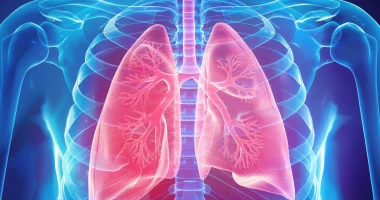Knee rheumatoid arthritis
General information
Knee rheumatoid arthritis is a chronic inflammatory autoimmune disease that affects the knee joints and can also affect internal organs and blood vessels. It can manifest in one knee (monoarthritis) or in the joint structures of both legs (polyarthritis).
Rheumatoid arthritis is diagnosed in people of different ages but is most often detected in people between the ages of 45 and 65. The characteristic feature of this disease is its progressive nature, which, if not controlled, can lead to severe disability.
This emphasizes the need for early diagnosis, systematic medical surveillance, and effective treatment to manage symptoms and slow disease progression.
Causes and risk factors
Taking into account etiologic factors, two types of knee arthritis are distinguished:
- Primary rheumatoid arthritis of the knee is an independent pathological process. It develops as a result of traumatic injury to the knee, in which there is penetration of an infectious agent into the cavity of the articular joint.
- Secondary arthritis develops against the background of other diseases. Infectious processes (tuberculosis, syphilis, etc.), systemic pathologies such as Bechterew’s disease and psoriasis, and purulent diseases (phlegmon, osteomyelitis) can lead to the development of arthritis.
Factors that contribute to the development of arthritis include:
- overweight;
- significant physical activity, including sports;
- abnormal joint mobility;
- flat feet;
- exposure to infections;
- hypersensitivity reactions;
- surgical interventions, in particular, artificial termination of pregnancy;
- childbirth;
- hypothermia.
Symptoms of rheumatoid arthritis of the knee
The main local (joint) manifestations include pain, swelling, and changes in the joint’s shape.
Rheumatoid arthritis of the knee joint is manifested by the following signs:
- Joint pain that may increase with movement;
- Swelling and increase in the size of the knee;
- Limitation of mobility and a feeling of stiffness after prolonged rest, such as after a night’s sleep;
- There is redness of the skin over the affected area, which is accompanied by a local increase in temperature;
- muscle tension, limiting the amplitude of movements (both passive and active).
Rheumatoid arthritis of the knee may be accompanied by general symptoms such as fatigue, weakness, and loss of appetite.
Purulent arthritis of the knee joint is manifested by a pronounced intoxication syndrome, including fever, chills, headache, and myalgia.
Diagnosis
Diagnostic measures in cases of suspected reactive knee arthritis begin with a rheumatologist or orthopedist examining the patient. Special attention is paid to determining its causes in identifying knee arthritis. The doctor conducts a detailed examination and studies the patient’s medical history and blood relatives.
Several laboratory and instrumental tests are then performed, including:
- general and biochemical blood work;
- radiographs;
- Ultrasound;
- MRI and CT;
- puncture diagnosis (analysis of joint fluid).
Diagnosis and treatment of rheumatoid arthritis of the knee is carried out by experienced specialists of the highest category, who have deep knowledge and professional skills in the field of rheumatology. Doctors use the latest equipment and modern diagnostic methods, allowing them to establish the correct diagnosis quickly and develop the most effective therapy scheme individually for each patient.
Complications of arthritis
Knee rheumatoid arthritis can lead to various complications, especially if the disease is not controlled by effective treatment. Complications can affect the joints, other organs, and body systems. Some of the most common complications include:
- joint destruction (destruction of cartilage and bone, resulting in deformity and loss of joint functionality);
- Osteoporosis and increased risk of fractures;
- cardiovascular diseases, particularly pericarditis and myocarditis;
- pneumonia;
- inflammation of the neck joints;
- depression and anxiety.
Treatment of rheumatoid arthritis of the knee
Rheumatoid arthritis of the knee in the acute period requires limiting the load on the joints. Patients should wear orthopedic shoes or canes. Adjustments to the diet are also recommended to reduce the load on the joints, as achieving a normal body weight plays a vital role in slowing the development of the disease and alleviating the patient’s condition.
Treatment for knee joint impingement is complex and includes:
- Pharmacotherapy. Antibiotics, nonsteroidal anti-inflammatory drugs, chondroprotectors, and rubbing topical ointments are prescribed. In some situations, corticosteroids and hyaluronic acid injections inside the joint are indicated.
- Physiotherapeutic methods. Treatment includes an individualized set of exercises, massage, and the application of physiotherapeutic procedures such as magnetotherapy and laser therapy.
- Surgical treatment. Surgical intervention – endoprosthesis – may be required in case of severe damage.
Chronic and progressive knee arthritis can eventually lead to permanent impairment of lower limb function. In most cases, it is possible to prevent the development of arthritis by avoiding injuries, excessive physical exertion, hypothermia, and controlling weight. Adequate treatment of infectious and rheumatic diseases should also be carried out to prevent secondary arthritis.
All these treatment options are available in more than 800 hospitals worldwide (https://doctor.global/results/diseases/knee-rheumatoid-arthritis). For example, Arthroscopic synovectomy of the knee joint can be done in these hospitals for following approximate prices:
Turkey $2.6 K in 26 clinics
Germany $10.6 K in 43 clinics
China $11.4 K in 8 clinics
United States $15.4 K in 17 clinics
Israel $31.7 K in 16 clinics.

